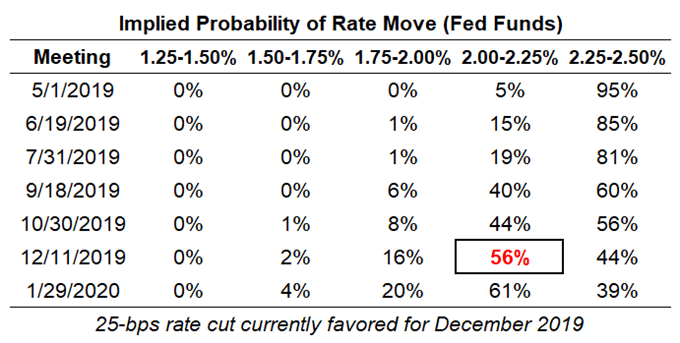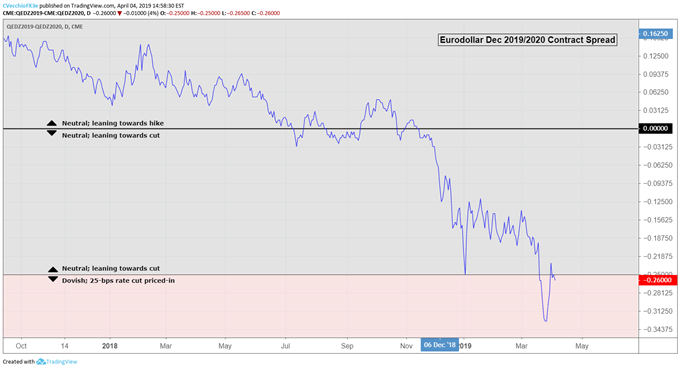Talking Points
- In line with the improvement in US growth expectations in recent weeks, Fed funds are no longer pricing in a 25-bps rate cut for this September; instead, odds slightly favor a cut in December.
- Eurodollar contract spreads have rebounded as have US Treasury yields; the ‘dove’ case from the Fed is being diminished across the board.
- Retail traders continue to trade against US Dollar strength.
Looking for longer-term forecasts on the US Dollar? Check out the DailyFX Trading Guides.
The US Dollar (via the DXY Index) has had a several few weeks since the March Fed meeting. While the initial reaction by the US Dollar was lower after Fed Chair Jerome Powell threw in the towel on a potential rate hike in 2019, the underlying cause – that global growth is slowing amid heightened trade tensions – has seemingly lost face value in recent days.
US Growth Expectations Have Rebounded
With the Atlanta Fed GDPNow Q1’19 growth tracker pointing to 2.1% annualized growth (up from 0.2% in the second week of March), we’ve seen US Treasury yields rebound and rate expectations rebound meaningful. All of the sudden, not only is the US Dollar benefiting from the perspective as a safe haven – there are plenty of concerns elsewhere – domestic developments are turning supportive in the short-term for the US Dollar once more.
Fed Funds are Now Discounting a December Rate Cut
It’s evident that traders were taking cues from the Fed’s warnings about global growth. Immediately after the March Fed meeting, odds of a September cut jumped from 16% to as high as 58%. But since their apex at the end of March, rate cut odds have climbed down significantly. No longer are Fed funds pricing in a cut for September (40%); instead, that’s been pushed back to December (56%).
Federal Reserve Rate Hike Expectations (April 4, 2019) (Table 1)

We can measure whether or not a rate cut is being priced-in for 2020 by examining the difference in borrowing costs for commercial banks over a one-year time horizon in the future. Whereas the spread between the Eurodollar June 2019 and 2020 contracts fell on a straight line after the March Fed meeting, we’ve seen cut expectations cool off meaningfully.
Eurodollar December 2019/2020 Spread: Daily Timeframe (October 2018 to April 2019) (Chart 1)

The Eurodollar December 2019 and 2020 contract spread was discounting -38.5-bps out at its extreme after the March Fed meeting, effectively one and one-half 25-bps cuts. But since rebounding, rates markets are only pricing-out -26-bps, or just one cut for 2020.
Read more: March US Nonfarm Payrolls & EURUSD Price Outlook
FX TRADING RESOURCES
Whether you are a new or experienced trader, DailyFX has multiple resources available to help you: an indicator for monitoring trader sentiment; quarterly trading forecasts; analytical and educational webinars held daily; trading guides to help you improve trading performance, and even one for those who are new to FX trading.
--- Written by Christopher Vecchio, CFA, Senior Currency Strategist
To contact Christopher Vecchio, e-mail at cvecchio@dailyfx.com
Follow him on Twitter at @CVecchioFX
View our long-term forecasts with the DailyFX Trading Guides






